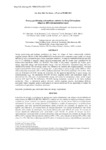Please use this identifier to cite or link to this item:
http://www.alice.cnptia.embrapa.br/alice/handle/doc/1022505| Title: | Energy partitioning and methane emission by sheep fed sorghum silages at different maturation stages. |
| Authors: | MACHADO, F. S.  GONÇALVES, L. C.   RODRIGUES, J. A. S.   RIBAS, M. N.   PÔSSAS, F. P.   JAYME, D. G.   PEREIRA, L. G. R.   CHAVES, A. V.   TOMICH, T. R.   |
| Affiliation: | FERNANDA SAMARINI MACHADO, CNPGL; JOSE AVELINO SANTOS RODRIGUES, CNPMS; LUIZ GUSTAVO RIBEIRO PEREIRA, CNPGL; THIERRY RIBEIRO TOMICH, CNPGL. |
| Date Issued: | 2015 |
| Citation: | Arquivo Brasileiro de Medicina Veterinária e Zootecnia, Belo Horizonte, v. 67, n. 3, p. 790-800, 2015. |
| Description: | ABSTRACT - Energy partitioning and methane production by sheep fed silages of three commercially available sorghum hybrids (BRS 610, BR 700 and BRS 655) harvested at three maturation stages (milk, soft dough and floury) were evaluated in open circuit respiration chambers. A complete randomized design was used in a 3 × 3 (hybrids × maturity stages) factorial arrangement, and the means were compared by the Student–Newman–Keuls (SNK) test (P<0.05). The intake of dry matter, digestible dry matter, gross energy, digestible energy and metabolizable energy were not affected by maturation stage, but were influenced by hybrid. The net energy intake was influenced by maturity and sorghum genetics. The fecal output represented the main source of energy loss, as percentage of gross energy intake (48% to 52%), followed by heat increment (10% to 19%), methane emissions (4% to 6%) and urine (1% to 2%). There were no differences (P>0.10) among the treatments for the apparent digestibility of gross energy and metabolizability (qm). An interaction (P<0.05) between sorghum hybrid and maturation stages was observed for the efficiency of metabolizable energy utilization for maintenance (km), which ranged between 0.53 and 0.78. No differences (P>0.10) among treatments occurred in the daily methane production. There is substantial genetic diversity within sorghum species, determining different nutritional values. Sorghum genetics and maturity at harvest should not be an opportunity to reduce the contribution of agriculture to methane emissions. RESUMO - A partição de energia e a produção de metano por ovinos alimentados com silagens de três híbridos de sorgo comerciais (BRS 610, BR 700 e BRS 655), colhidos em três estádios de maturação (leitoso, pastoso e farináceo), foram avaliadas em câmaras respirométricas de circuito aberto. Utilizou-se delineamento inteiramente ao acaso, em arranjo fatorial 3 x 3 (híbridos x estádios de maturação), e as médias foram comparadas pelo teste Student?Newman?Keuls (SNK) (P<0,05). Os consumos de matéria seca, de matéria seca digestível, de energia bruta, de energia digestível e de energia metabolizável não foram afetados pelo estádio de maturação, mas foram influenciados pelo híbrido de sorgo. O consumo de energia líquida foi influenciado pela maturidade e pelo híbrido. As perdas de energia nas fezes representaram a principal fonte de perda energética como porcentagem do consumo de energia bruta (48% a 52%), seguida pelo incremento calórico (10% a 19%), pela emissão de metano (4% a 6%) e pela urina (1 a 2%). Não houve diferenças (p>0,10) entre os tratamentos para a digestibilidade aparente da energia bruta e para a metabolizabilidade (qm). Foi observada interação (P<0,05) entre híbrido de sorgo e estádio de maturação para eficiência de uso da energia metabolizável para mantença (Km), que variou entre 0,53 e 0,78. Não ocorreram diferenças (p>0,10) entre tratamentos na produção diária de metano. A emissão de metano em gramas por kg de matéria seca digestível e por kg de fibra em detergente neutro digestível foi inferior no estádio pastoso comparado ao estádio farináceo. |
| Thesagro: | Gado Sorgo Silagem Metano |
| Keywords: | Energia líquida Gás efeito estufa Respirometria Valor nutricional |
| DOI: | 10.1590/1678-4162-7177 |
| Type of Material: | Artigo de periódico |
| Access: | openAccess |
| Appears in Collections: | Artigo em periódico indexado (CNPMS)  |
Files in This Item:
| File | Description | Size | Format | |
|---|---|---|---|---|
| Energypartitioning.pdf | 320.26 kB | Adobe PDF |  View/Open |









